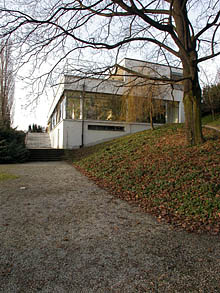
Vila Tugendhat should remain in Brno, said the councilors
 |
Brno's leadership refuses to donate the villa, which is listed on the UNESCO list, directly to the descendants of the original owners. If the monument were to be donated abroad, the city would have to pay a gift tax to the state. For a property valued at over 50 million crowns, the tax would amount to 40 percent of the price, said Deputy Mayor Barbora Javorová to ČTK.
Augustin Kohoutek, the legal representative of the Tugendhats, disagrees with the councilors' decision. "If the villa is not returned to the Tugendhat family, we will simply sue," Kohoutek said to ČTK today.
The councilors also agreed today that Brno should initiate further meetings with the Tugendhats. Both parties should communicate about how to proceed with necessary repairs to the monument and how to keep it accessible to the public. They did not express this commitment in writing in the resolution, but the politicians agreed on this idea, the deputy said.
The Tugendhats requested the return of the villa under the law addressing certain injustices caused by the Holocaust. Brno's representatives voted at their previous session that the Tugendhat siblings should get the villa back, but they decided that the state should transfer the property to them. However, the Ministry of Finance, the Ministry of Culture, and the Office for Representation of the State in Property Matters refused to take over the monument.
The Tugendhat villa has been listed as the only Czech building of modern architecture on the UNESCO list since 2001. The building, located in the residential district of Černá Pole, was designed in 1928 by German architect Ludwig Mies van der Rohe. According to experts, it was unique in its spatial concept, choice of materials, and furnishings. It is currently in poor technical condition and needs renovation. Brno committed to repair it six years ago during discussions about its inscription on the UNESCO list. However, disputes regarding the tender for the restoration designer delayed the start of work by approximately two years.
The technical condition of the villa continues to deteriorate, and the building manager is currently addressing another in a series of sewage emergencies. According to architect Iveta Černá, who is responsible for the management of the monument, the last emergency will be addressed with immediate repairs. During this, a special substance will be injected into the sewage pipe at the location of the rupture, which will create a solid ring inside and seal the crack. The reconstruction of the entire sewage system will wait until the overall restoration.
The mayor of Brno told reporters today that if the representatives approve keeping the monument in the ownership of the city, he will do everything possible to take immediate steps leading to repairs. However, he did not dare to estimate when the restoration would begin.
The English translation is powered by AI tool. Switch to Czech to view the original text source.
1 comment
add comment
Subject
Author
Date
Vila Tugendhat by měla ...
Tomáš Příhoda
20.03.07 12:25
show all comments
Related articles
0
08.02.2011 | The restoration of the Tugendhat villa in Brno has entered its second half
1
31.12.2009 | Vila Tugendhat will close today for restoration
0
21.05.2009 | European experts will evaluate the restoration plan for the Tugendhat villa
1
09.03.2009 | Diary: Heritage experts set a deadline for the renovation of the Tugendhat Villa in Brno












